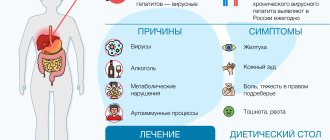General information
Esophageal atresia is a pathology of the digestive tract related to severe developmental defects.
It consists of a blind end of the upper (oral) or disconnection from the lower (abdominal) segment of the esophagus (ICD-10: Q39.0), as well as its communication with the trachea - in the presence of the so-called tracheal-esophageal fistula (ICD-10: Q39. 1). A developmental anomaly is found in 1 newborn per 1-5 thousand children, regardless of gender. Identification of an isolated congenital tracheoesophageal fistula occurs in approximately 3-4% of cases of congenital abnormalities of the esophagus. Children with esophageal atresia quite often have other developmental anomalies and congenital defects of the heart, genitourinary system, gastrointestinal tract, as well as anomalies of the limbs and chromosomal disorders, which significantly reduces their survival.
1.General information
In medicine, there are many synonyms to denote pathological narrowing, blockage or blockage of the lumen - obstruction, obstruction, embolism, stricture, obliteration, etc. The term “atresia” means something else: the natural channel in the body is completely closed and is absent as such. Most often, atresia is congenital: at the stage of intrauterine development, any opening or duct does not open, does not form, and by the time of birth remains a blind “dead end”. Any anomaly of this kind is severe, and often already in the first days or even hours after birth it poses a direct threat to life.
The above applies fully to esophageal atresia. This is one of the most severe variants of prenatal dysontogenesis, in which the esophagus at the level of ten to twelve centimeters below the larynx is blocked by an overgrown dead end.
Esophageal atresia occurs in one case per 3-5 thousand newborns, and this frequency does not allow us to classify this anomaly as a very rare disease, or simply rare: in domestic medicine, diseases with an incidence of 1:10,000 or less are usually considered rare.
The risk of esophageal atresia does not vary by gender or race.
A must read! Help with treatment and hospitalization!
Pathogenesis
This anomaly in the structure of the esophagus is based on a violation of the early intrauterine stages of embryo development. The rudiment of the trachea and esophagus is the head end of the foregut and initially they have a wide connection with each other. The separation process usually occurs around the 5th week of pregnancy.
The processes of vacuolization at the solid stage, the discrepancy between the speed and direction of growth of the trachea with the esophagus and other formations of the digestive tube from 20 to 40 days of embryogenesis lead to such a severe anomaly incompatible with life. The threat to existence begins immediately at birth, since when contents from the stomach, mucus or milk enter the trachea through feeding, aspiration pneumonia and respiratory failure , and the blind end of the esophagus leads to exhaustion. Therefore, identifying the defect in the first hours of life and restoring the normal course of the food tube requires immediate surgical intervention and gives the best prognosis.
Typical pregnancy disorders are polyhydramnios and the risk of miscarriage , especially in the first trimester.
Discussion
Tracheomalacia is a common cause of respiratory distress among patients with A.P. One recent study reported the development of tracheomalacia in 87% of patients with AP [3]. Data obtained from earlier scientific studies indicate the prevalence of tracheomalacia in 11-33% of patients with AP and probably underestimate this disease, given the wide range of clinical manifestations of this anomaly [1, 5, 13-18]. An incorrect assessment of the results of tracheobronchoscopy may play a certain role in the incorrect diagnosis. Early and accurate diagnosis of tracheomalacia is very important, especially from the point of view of the fact that obstruction of the tracheal lumen leads to ineffective spontaneous breathing and poor clearance of the tracheobronchial tree from secretions, which contribute to the occurrence of a chronic inflammatory process in the lungs in 27% of patients with AP [4, 16, 18 -20]. Effective treatment of tracheomalacia remains a challenge and currently does not find consensus in the field of its diagnosis, assessment of severity and choice of surgical tactics [3, 4, 6, 21].
It is quite difficult to standardize the diagnosis of tracheomalacia, since the degree and extent of collapse of the tracheal lumen still remain subjective criteria. Pre- and postoperative endoscopic assessment of the airway in patients with AP is necessary for a reliable diagnosis of tracheomalacia. Diagnostic laryngoscopy and bronchoscopy, which are performed under general anesthesia while patients are spontaneously breathing, are necessary to assess the condition of the glottis in order to search for a laryngeal cleft, distal and proximal tracheoesophageal fistula, as well as a dynamic study of the condition of the tracheal lumen throughout the entire respiratory cycle. R. Jennings proposed a scale for assessing the severity of tracheomalacia, based on determining the degree of narrowing of the lumen of the trachea and bronchi, measured in several areas of the trachea [6, 9, 20]. The greater the severity of airway obstruction, the lower the score, which, in combination with clinical symptoms, will be an indication for surgical correction. A standardized scoring system based on dynamic airway assessment is used to determine pre- and postoperative indicators of tracheomalacia severity [6, 9, 20].
Another controversial aspect of diagnosing tracheomalacia in patients with AP concerns the performance of tracheobronchoscopy in the preoperative period. The routine use of preoperative tracheobronchoscopy as an adjunct to preoperative evaluation of the complex malformations encountered in AP is controversial, and only 21.5–60% of surgeons perform tracheobronchoscopy preoperatively [22–24].
Surgical options for the treatment of tracheomalacia include procedures of anterior (ascending aorta) or posterior (descending aorta) aortopexy, anterior or posterior tracheopexy, tracheal resection with anastomosis, or external stabilization [3-4, 6-7, 9, 25-27]. Anterior aortopexy with sternal fixation of the ascending aorta is the most commonly used treatment for tracheomalacia. However, literature data report the ineffectiveness of this procedure in 10-25% of patients [25-27].
Interestingly, posterior tracheopexy to the anterior longitudinal spinal ligament was originally developed to prevent recurrence of tracheoesophageal fistula [28]. However, subsequent tracheobronchoscopy revealed that posterior tracheopexy was also quite effective for the treatment of tracheomalacia [3, 6, 9]. Most of these operations are performed during reoperations after primary esophageal reconstruction.
More recently, it has been demonstrated that posterior tracheopexy can be performed simultaneously with construction of the esophageal anastomosis. H. Shieh demonstrated that posterior tracheopexy was performed in 28% of primary cases and 10% of secondary cases of AP treatment.
If posterior tracheopexy is used for the primary treatment of tracheomalacia diagnosed immediately after birth, it is not possible to trace the natural evolution of these cases of tracheal anomaly. There is, however, evidence that one-quarter of patients with persistent tracheomalacia develop irreversible bronchiectasis by age 8 [18]. Therefore, the current view of this problem implies that posterior tracheopexy can be safely performed during the initial reconstruction of the AP without additional risk of complications and significant prolongation of operative time. This brand new procedure, designed to open the trachea in patients with tracheomalacia, may prevent the future development of chronic bronchopulmonary diseases and the repeat surgery required to correct tracheomalacia.
Classification
Classifications of esophageal atresia are usually based on the anatomical features of the structure; 5 types are distinguished:
- in children, the esophagus is completely absent and it is replaced by a connective tissue cord, while there is a lack of lumen and articulation with the trachea in the form of complete aplasia of the esophageal tube;
- the esophagus is formed by two isolated blind sacs, which can touch or overlap each other, the main sign of this condition is the visualization of the oral blind sac during contrast radiography and the absence of gas in the gastrointestinal tract;
- the end of the upper segment of the esophagus is blind, and the lower one is connected to the trachea by means of a fistulous tract slightly above or at the site of bifurcation (bifurcation) of the trachea, and can even open into the right bronchus;
- there is a connection between the oral part of the esophagus and the trachea, and the lower end ends blindly;
- the presence of double fistulas, in which the upper segment of the esophagus may be larger in diameter and hypertrophied than the lower one, while the second segment may be thinned.
Types of esophageal atresia
The size and location of the fistula tracts can be different. They are usually located at the level of the second or third thoracic vertebra, connecting with the posterolateral part of the wall of the trachea or bronchi at the level of the first thoracic vertebra and above, the second or third thoracic vertebra and even below the third thoracic vertebra, which is observed most often. The diastasis between the oral and abdominal ends can range from a few millimeters to several centimeters.
Symptoms
The clinical picture of esophageal atresia is pronounced and unfolds in the first minutes of a newborn’s life, and the following is observed:
- the presence of continuous heavy discharge and foamy saliva from the mouth and nose, that is, false hypersalivation ;
- when saliva enters the respiratory tract, signs of respiratory distress are observed in the form of perioral cyanosis , wheezing, cough, tachypnea , shortness of breath , arrhythmia , asphyxia , etc.; temporary improvement can only be achieved by suctioning mucus from the upper airways, which may have a yellowish tint due to for impurities of bile acids;
- the first feeding is accompanied by milk entering the respiratory tract, which obstructs the entry of air into the lungs and cyanosis occurs, the child may choke and cough, and in the future the condition is complicated by vomiting of unchanged masses;
- bloating caused by air entering the stomach through the trachea;
- development of respiratory failure, aspiration pneumonia and distress syndrome as a result of reflux of gastric contents into the lumen of the trachea during tracheoesophageal fistula;
- complete atresia leads to dehydration and exhaustion;
- the condition may be complicated by respiratory acidosis, polycythemia , and increased hematocrit .
Other anomalies and malformations found in children with esophageal atresia
- tracheoesophageal fistula is the main developmental abnormality, occurring in 80-90% of cases;
- Choanal atresia;
- stenosis of the pyloric part of the gastric cavity;
- biliary agenesis;
- congenital heart defects;
- jejunal atresia;
- micrognathia;
- hypertelorism;
- microcephaly;
- hydrocephalus;
- hypoplasia of the facial bones of the skull , characteristic of trisomy of chromosomes 21, 18, 13-15.
Is it possible to diagnose a baby in the womb?
Diagnosis of pathology in the fetus is called prenatal. It can be based on the following indirect signs that are detected by ultrasound:
- polyhydramnios - with a significant increase in weight of the pregnant woman, in this case it is associated with a reduced turnover of amniotic fluid due to the inability of the fetus to swallow amniotic fluid;
- lack of image of the contours of the stomach or its too small size in dynamics during observation.
The probability of confirming pathology based on these signs reaches 50%. In the second and third trimesters, an experienced doctor notices periods of filling and emptying of the blind end of the esophagus. There are reports of the importance of determining the content of the enzyme acetylcholinesterase in the amniotic fluid of the fetus if a congenital pathology is suspected during pregnancy.
Tests and diagnostics
To exclude esophageal atresia within the walls of the delivery room:
- carry out the Elephant test - using a syringe and a probe installed in the blind end of the esophagus, they begin to supply air; a sign of a violation is considered if it comes out of the mouth and nasal passages with noise;
- A radiopaque probe with a non-traumatic end is inserted through the nose into the esophagus; in the case of an anomaly of the esophagus, an obstacle in the form of a blind end is encountered along the rubber catheter, so it is wrapped and returned to the child’s oral cavity.
To determine the characteristics of the malformation, an x-ray examination of the chest and abdominal organs is performed in direct and lateral projections. It can be performed without the use of a contrast agent, which, also in case of abnormal development of the esophagus, is characterized by the “return” of a rolled up radiopaque probe. When contrast is used, it flows into the trachea or the blind end is clearly demonstrated. If there is a trachial-esophageal fistula, then air penetration into the stomach is observed, otherwise a picture of a total eclipse of the abdominal cavity in children with a sunken abdomen is visible.
To determine the characteristics of a tracheoesophageal fistula, the most indicative are esophagoscopy and tracheobronchoscopy.
To exclude concomitant anomalies, it is recommended to perform ultrasound of the excretory system, neurosonography and ECHO-CG.
Anastomosis requires suturing the mediastinal pleura over the esophagus and tightly closing the chest in layers, while simultaneously straightening the lungs using an endotracheonarcosis device. In addition, a control x-ray is taken to determine the degree of expansion of the lung. The catheter from the esophagus can be carefully removed after 24 hours.
results
During the operation, no complications were noted in the form of bleeding, disruption of neural structures (vagus or recurrent nerve), or damage to the posterior wall of the trachea. Posterior tracheopexy did not cause additional difficulties in performing an esophageal anastomosis. The duration of the surgical intervention was 85 minutes. The duration of artificial ventilation after surgery is 1 day. Tracheal decannulation was performed on the 3rd day. Spontaneous breathing was effective and provided effective gas exchange. Tachypnea and retractions of the compliant areas of the chest were absent. A contrast study of the esophagus was performed on the 7th day after surgery and demonstrated good patency of the esophagus without signs of leakage. The gastric tube and drainage tube located in the posterior mediastinum were removed on the same day, and oral nutrition began on the same day. On the 10th day of life, tracheobronchoscopy was performed, which demonstrated complete opening of the tracheal lumen with moderate prolapse of the membranous part in the second segment of the trachea. The assessment of the degree of tracheal patency according to the R. Jennings tracheomalacia severity scale was 480 points. During observation of the patient for 5 months, no increase in symptoms of respiratory disorders was detected. The patient demonstrated excellent weight and height indicators characteristic of his age.
Procedures and operations
The problem of esophageal atresia can be solved using thoracotomy - an open surgical intervention or by performing a one-stage thoratoscopic procedure. The main purpose of which is to divide the tracheal-esophageal fistula with the further imposition of a direct anastomosis connecting the ends of the esophagus. Such manipulations are feasible if the size of the diastasis does not exceed 1.5-2 cm. In other cases, a cervical esophagostomy and Kader gastrostomy are applied, and after 2-3 months. Children under 3 years of age undergo esophagoplasty using a colon graft.
The first successful reconstruction of the esophagus was carried out in 1939; over the subsequent years, many methods of anastomosis have been developed, depending on the characteristics of the esophageal defects:
- Haight and Towsley in 1943 proposed to perform a primary anastomosis by connecting segments of the esophagus “end to end”, but this technique is only suitable for small diastasis sizes;
- Daniel a year later used a catheter to create an anastomosis, which he inserted into the esophagus nasally before the start of surgery and removed it during the cutting of the thread fixing the distal segment of the esophagus with the catheter, but this method runs the risk of narrowing at the site of the anastomosis;
- surgeon Ladd proposed the idea of connecting both ends of the esophagus using special wrapping sutures, which makes it possible to reconstruct under tension and reduces the risk of threads cutting through the delicate tissues of the child’s body;
- Gross and Scott in 1946 managed to develop a method of oblique anastomosis to restore the esophageal tube, in addition to its unique method of suturing Ladd, the structure is strengthened with separate silk threads, which made it possible to significantly reduce the risk of strictures at the suturing sites;
- Ten Kate in 1952 would offer a unique addition to the technique of reproducing anastomoses by lengthening the oral segment and reducing tension in the case of diastasis between segments of the esophagus, but it entailed the risk of cicatricial changes and obstruction in the postoperative period;
- the “end to side” technique is used in the simplest cases of the blind ends of the esophagus going “one by one” and their contact without tension;
- Mechanical suturing of segments of the esophagus using a hardware mechanical suture can significantly reduce the operation time, but it has its own contraindications: significant diastasis of more than 1.5 cm and significant underdevelopment of the distal segment of the esophagus.
Esophageal atresia in newborns
In newborns, anomalies often develop in combination with congenital defects of other organs and systems. Esophageal atresia is considered one of the most severe types of disorders, because the child has virtually no chance of survival without early surgical intervention.
Preparation for surgery should begin immediately and be accompanied by constant aspiration of the contents of the oropharynx and nasopharynx every 15-20 minutes. In addition, it is necessary to supply humidified oxygen, warming in an incubator, and completely eliminate oral feeding. To stabilize the condition, infusion, antibacterial (broad-spectrum drugs) and symptomatic therapy may be necessary to combat disturbances of homeostasis , hemodynamics , respiratory failure and dehydration .
4.Treatment
Obviously, the time factor is vital: in the perinatal period, death from exhaustion and respiratory disorders occurs very quickly if the diagnosis is made late or incorrectly, as a result of which urgent surgical intervention (the only life-saving treatment) is not performed.
Intensive preoperative preparation is required - wet oxygenation of the lungs, drainage of mucus and saliva, bronchoscopy, administration of antibiotic cover - and the more time has passed since birth, the longer it takes to prepare the patient for surgery. Sometimes the intervention becomes two-stage (first, the fistula is removed and a gastrostomy is formed to provide nutrition, then the patency of the esophagus is restored). In general, open abdominal operations of this kind are always complex and risky; the technique often has to be corrected on the operating table; the prognosis is further (and significantly) worsened by the presence of concomitant anomalies in other body systems. The postoperative period is no less complex and dangerous.
The literature provides data that with isolated (without fistula and other complications) esophageal atresia, the survival rate of operated newborns ranges between 90% and 100%; the presence of concomitant congenital anomalies in vital organs (heart, kidneys, etc.) reduces this figure to 30-50%.
Esophageal atresia in children under 3 years of age in the postoperative period
The postoperative condition can be complicated by many different severe side effects, which requires constant medical observation and control fibroesophagogastroscopy, and in some cases, emergency medical care. These include:
- dysphagia (swallowing disorder);
- cardia failure;
- gastrointestinal reflux, causing nocturnal regurgitation and regurgitation;
- repeated pneumonia ;
- narrowing of anastomoses, which raises the question of the need for bougienage;
- In many children, postoperative injury to the laryngeal recurrent nerve causes hoarseness within 6-12 months.
Diet for esophageal atresia
Postoperative diet
- Efficacy: therapeutic effect after 21 days
- Terms: 1-6 months
- Cost of products: 1300-1500 rubles. in Week
Since the baby cannot be helped by any conservative treatment, but only by immediate surgical intervention, it is very important for young parents to familiarize themselves with the list of nutritional recommendations during the postoperative period. These include:
- feeding with homogenized food masses;
- constant clinical observation; in case of dysphagia or obstruction, urgent esophagoscopy is necessary;
- For children who are old enough, soups, broths and liquid porridges can be included in the menu.




